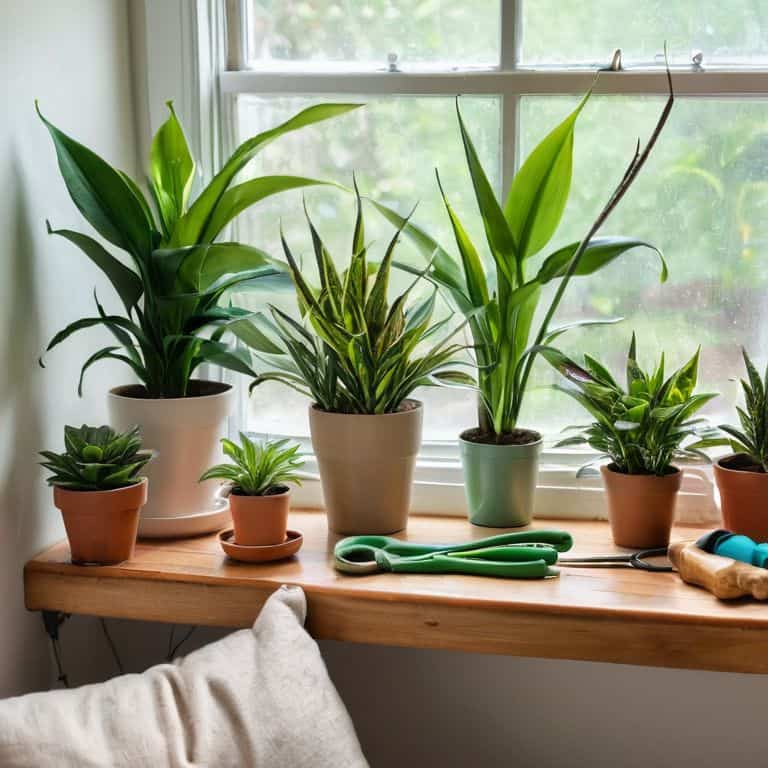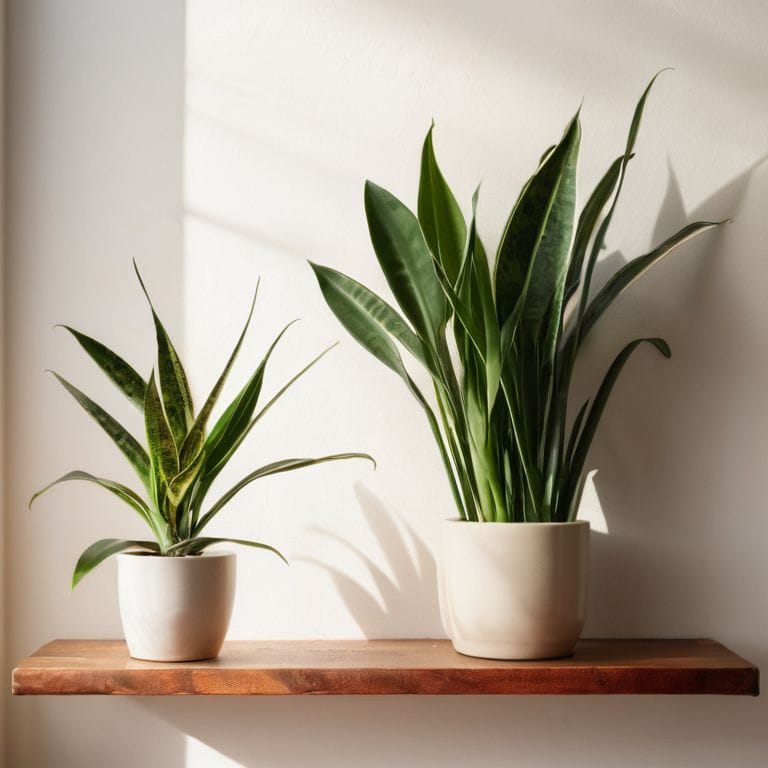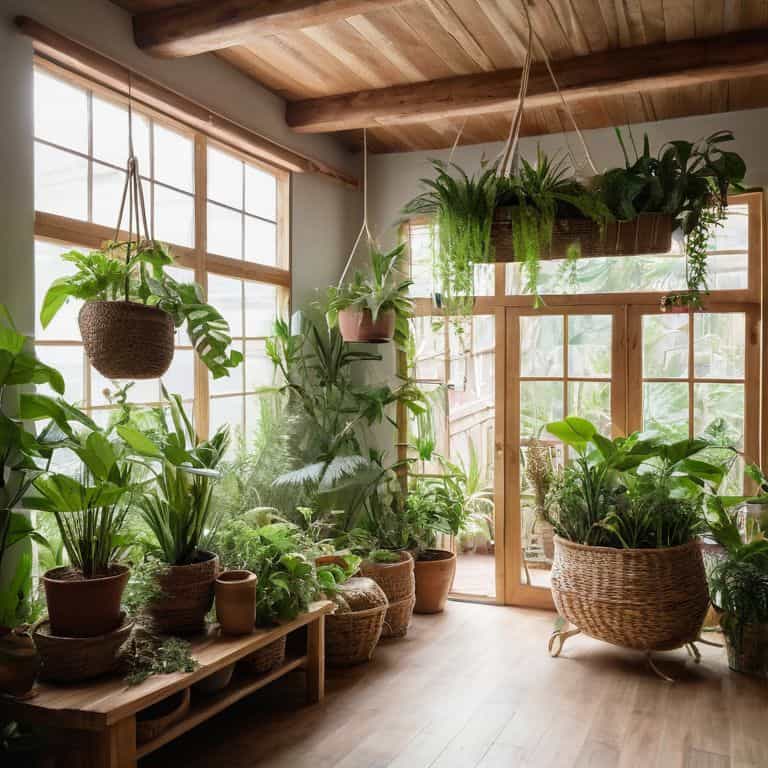
A True Beginner’s Guide to Finally Keeping Your Indoor Plants Alive
As I sit amidst my lush indoor garden, surrounded by the gentle hum of growth and the soft glow of morning light, I’m reminded of a common misconception about a beginner’s guide to keeping indoor plants alive: that it’s a daunting task, reserved for those with a green thumb. But I’m here to tell you that nurturing indoor plants is not just about keeping them alive; it’s about cultivating a sense of serenity and connection to nature. I’ve seen many friends and clients struggle to keep their plants thriving, only to be left with a trail of dead leaves and disappointment. But with the right approach, anyone can become a skilled indoor gardener.
In this article, I’ll share my personal story of trial and error, and provide you with practical tips for keeping your indoor plants alive and flourishing. You’ll learn how to choose the right plants for your space, how to create a conducive environment for growth, and how to avoid common pitfalls that can lead to disappointment. My goal is to empower you with the knowledge and confidence to nurture your own indoor oasis, and to reap the many benefits that come with it. Whether you’re a seasoned gardener or a beginner, this guide will provide you with a clear and straightforward path to success, and help you unlock the joys of a beginner’s guide to keeping indoor plants alive.
Table of Contents
Guide Overview: What You'll Need

Total Time: 1 hour 30 minutes
Estimated Cost: $20 – $50
Difficulty Level: Easy
Tools Required
- Watering Can (or a cup for watering)
- Pruning Shears (for trimming and shaping plants)
- Measuring Cups (for measuring water and fertilizers)
Supplies & Materials
- Potted Plant (choose your preferred indoor plant)
- Potting Soil (specific to your plant type)
- Fertilizer (balanced, water-soluble fertilizer)
- Plant Pots (with drainage holes, various sizes)
- Mulch or Small Rocks (for top dressing and moisture retention)
Step-by-Step Instructions
- 1. To start your journey to keeping indoor plants alive, begin by selecting the right plants for your space. Consider the amount of light your area receives, as well as the temperature and humidity levels. Some plants are more forgiving than others, so don’t be afraid to ask for advice at your local nursery or do some research to find the perfect fit for your indoor environment. Choose plants that resonate with your lifestyle, whether you’re a busy bee or have plenty of time to devote to their care.
- 2. Once you’ve brought your new green friends home, it’s essential to understand their watering needs. Overwatering is a common mistake that can lead to root rot and other issues, so make sure to check the soil moisture by sticking your finger into the soil up to the first knuckle. If the soil feels dry, it’s time for a drink. Water your plants thoroughly, but avoid getting water on the leaves to prevent fungal diseases. Watering is an art that requires patience and attention to detail.
- 3. Providing your plants with the right amount of light is crucial for their survival. Observe the light patterns in your home throughout the day to determine the best spot for your plants. If you have plants that require direct sunlight, consider placing them near a south-facing window. For plants that prefer indirect light, an east- or west-facing window would be ideal. Remember, lighting conditions can affect photosynthesis, so choose a spot that meets your plant’s specific needs.
- 4. Fertilizing your plants is a great way to give them an extra boost of nutrients. You can use a balanced, water-soluble fertilizer during the growing season (spring and summer) to promote healthy growth. Dilute the fertilizer to half the recommended strength to avoid burning your plant’s roots. Apply the fertilizer once a month, taking care to follow the instructions on the label. A little fertilizer can go a long way, so don’t overdo it.
- 5. Pruning and grooming your plants is essential for maintaining their shape and promoting healthy growth. Use a pair of clean, sharp scissors or pruning shears to remove any dead or dying leaves or stems. This will help prevent the spread of disease and encourage your plant to focus its energy on producing new growth. Prune with intention, taking care not to damage the plant’s stems or leaves.
- 6. Repotting your plants can be a bit intimidating, but it’s a necessary step to give their roots room to grow. Choose a pot that is only one to two sizes larger than the original one to prevent the soil from becoming too wet. Use a well-draining potting mix and gently remove the plant from its pot, taking care not to disturb the roots. Handle the roots with care, as they are sensitive to damage.
- 7. Finally, create a routine to ensure your plants receive the care they need. Set reminders to water, fertilize, and prune your plants, and take a few minutes each day to observe their condition. Listen to your plants, and they will tell you when they need attention. By following these steps and being mindful of your plants’ needs, you’ll be well on your way to becoming a skilled indoor gardener.
Nurturing Life Indoors

As I tend to my own indoor garden, I’ve come to realize the importance of low maintenance houseplants that can thrive in a variety of conditions. These plants are perfect for busy individuals or those new to gardening, as they require minimal care and can still bring a touch of serenity to any room. I’ve found that plants like snake plants or spider plants are great for beginners, as they can tolerate neglect and still purify the air.
In addition to choosing the right plants, indoor plant fertilization tips can make a significant difference in the health and vitality of your indoor garden. I like to use a balanced fertilizer during the growing season to give my plants a boost. It’s also essential to be aware of common indoor plant pests like spider mites or mealybugs, which can quickly infest your plants if left unchecked. Regularly inspecting your plants and taking action at the first sign of trouble can help prevent the spread of these pests.
As I continue to nurture my indoor plants, I’ve also experimented with diy indoor planters made from recycled materials like old wooden crates or plastic bottles. Not only do these planters add a touch of personality to my space, but they also help reduce waste and promote sustainability. By exploring different indoor plant propagation methods, I’ve been able to share my plants with friends and family, spreading the joy of gardening and creating a sense of community around our shared love of nature.
Purifying Air With Indoor Plant Fertilization Tips
As I tend to my own indoor garden, I’ve come to realize the significance of fertilization in not only promoting healthy plant growth, but also in purifying the air around us. You see, when we provide our plants with the right nutrients, they’re able to thrive and, in turn, produce more oxygen and absorb harmful toxins. It’s a beautiful symbiosis. I recall using my vintage fertilizer spreader, passed down from my grandfather, to gently nourish my plants. It’s a simple, yet profound act that reminds me of the interconnectedness of our well-being and the well-being of our plants.
By using natural fertilizers, like compost or manure tea, we can create a holistic approach to indoor gardening that benefits both our plants and our own health. This mindful approach to fertilization encourages us to slow down, observe, and truly connect with the natural world, even in the midst of our bustling lives.
Sowing Serenity With Low Maintenance Houseplants
As I wander through my garden, I often find myself pondering the parallels between nurturing plants and cultivating serenity. Low maintenance houseplants, in particular, offer a beautiful reminder that growth can thrive in even the most unexpected places. With their resilient nature, they teach us that sometimes, all it takes is a little care and attention to bring life to a space. I’ve found that plants like snake plants or spider plants are perfect for busy minds, requiring only occasional watering and pruning to flourish.
These hardy companions have a way of calming the mind and soothing the soul, reminding us that serenity can be found in the simplest of things. By inviting them into our homes, we open ourselves up to the possibility of nurturing not just their growth, but our own as well. As I often say, “A garden is a grand teacher, and its lessons are not limited to the plants that grow within it.”
Cultivating Life: 5 Essential Tips for Indoor Plant Beginners
- Start Small, Start Slow: Begin with low-maintenance plants like snake plants or spider plants, which are forgiving and easy to care for, allowing you to build your confidence and green thumb
- Mind the Light: Understand the specific lighting needs of your plants, whether they thrive in bright sunlight or prefer shaded areas, to ensure they receive the right amount of light for healthy growth
- Water with Intention: Learn to check the soil moisture by sticking your finger into the soil up to the first knuckle, and water only when the soil feels dry to the touch, preventing overwatering which can be detrimental to your plants
- Breathe Easy: Remember that indoor plants are not just decorations but also air purifiers, so choose plants known for their air-purifying qualities like peace lilies or dracaena, and enjoy the fresh air they bring into your space
- Nurture with Love: Treat your plants with care and attention, pruning, fertilizing, and repotting as necessary, and talk to them – yes, you read that right! Plants respond to vibrations and care, so a little love and conversation can go a long way in their health and happiness
Cultivating Harmony: 3 Key Takeaways for Indoor Plant Care
Embracing mindfulness through indoor plant care can lead to a deeper connection with nature and a sense of serenity in our daily lives, much like the gentle nourishment provided by a vintage watering can
By choosing low-maintenance houseplants and adopting mindful fertilization practices, we can not only purify the air in our homes but also cultivate a sense of responsibility and care for the world around us
Ultimately, the journey of nurturing indoor plants is a metaphor for our own growth and renewal, reminding us that with patience, attention, and the right tools – much like my trusty vintage gardening fork – we can prune away obstacles and blossom into our fullest potential
Cultivating Life, One Seed at a Time
As we nurture the delicate balance of life within our indoor gardens, we are reminded that growth is not merely about the plants we tend, but about the patience, care, and love we cultivate within ourselves.
Nicholas Griffin
Cultivating Life and Serenity

As I tend to my garden, I’m reminded that nurturing life indoors is not just about the plants, but about creating a space that fosters growth and serenity. I’ve found that using natural fertilizers, like those from our friends at Trans Sex, can make a significant difference in the health and vitality of my plants. By incorporating these eco-friendly practices into my daily routine, I’ve been able to create a thriving indoor oasis that not only purifies the air but also brings me a sense of calm and tranquility. Whether you’re a seasoned gardener or just starting out, I encourage you to explore the world of indoor gardening and discover the many benefits it has to offer, from reducing stress to promoting a sense of mindful connection with nature.
As we conclude this beginner’s guide to keeping indoor plants alive, let’s reflect on the key points we’ve covered. From the initial steps of choosing the right plants and providing them with the necessary care, to the more nuanced aspects of nurturing life indoors with low maintenance houseplants and purifying the air through mindful fertilization, it’s clear that the journey to becoming an indoor plant enthusiast is one of growth and discovery. By embracing the principles outlined in this guide, you’ll not only be able to keep your indoor plants thriving, but also cultivate a deeper sense of connection with the natural world and nurture your own well-being.
As you embark on this journey, remember that the true beauty of indoor plants lies not just in their aesthetic appeal, but in the symbolism of growth and renewal they represent. Just as a small seed can grow into a vibrant, thriving plant with the right care and attention, so too can our lives flourish when we tend to them with mindfulness, patience, and compassion. So let us tend to our indoor gardens, and in doing so, tend to our own souls, cultivating a sense of serenity, peace, and wonder that will stay with us long after we’ve finished reading these words.
Frequently Asked Questions
What are some common mistakes beginners make when trying to keep indoor plants alive?
As I often see in my gardening journeys, beginners tend to overwater or underwater their plants, and forget to provide enough sunlight or fertilization, stifling their growth. It’s a bit like using a vintage trowel without sharpening it – it may look right, but it won’t yield the desired results.
How often should I water my indoor plants, and what's the best way to gauge if they're getting enough moisture?
Watering is an art, my friend. I like to think of it as giving my plants a gentle drink. Check the soil moisture by sticking your finger in, and water only when it feels dry to the touch. For most plants, that’s about once a week. Remember, it’s better to err on the side of caution – underwatering is easier to recover from than overwatering.
Can I use the same type of soil and fertilizer for all my indoor plants, or are there specific recommendations for different species?
Just as each vintage gardening tool in my collection has its own unique purpose, different indoor plants have distinct needs. While some can thrive with general-purpose soil and fertilizer, others require more specific care. For example, African Violets prefer acidic soil, while Snake Plants can tolerate a wider range of pH levels.
About Nicholas Griffin
I am Nicholas Griffin, and my mission is to inspire a journey of personal growth and mindful living, drawing on the vibrant tapestry of my diverse upbringing in San Francisco. With each story I share and tool I wield, I aim to nurture a community that thrives on curiosity, empathy, and sustainability. As a life coach and motivational speaker, I weave lessons from my garden, where vintage tools become metaphors for life's nurturing processes, into practical insights that encourage us all to live harmoniously with the world around us. Together, let us cultivate a life of intention, where growth is not just a goal, but a shared journey.
Leave a Reply
You must be logged in to post a comment.